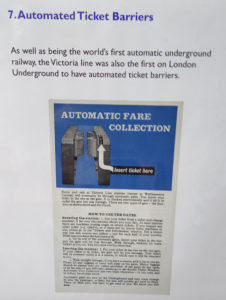The “Pumphouse Museum”:https://walthamstowpumphouse.org.uk/ in Walthamstow is located in a Grade II listed building. Built in 1885, it was originally a sewage pumping station.
At the entrance stands one of a working pair of original Marshall steam engines which are also Grade II listed. These engines are run once a month along with a selection of smaller stationary engines but we were there on the first Sunday after Covid re-opening and weren’t lucky.
On display are two half tube carriages from the Victoria Line. Both are of 1967 stock, but one had been renovated and as they were side by side, it was easy to spot the differences. The original having a silver exterior, wooden floors, high arm rests and not the familiar red, white and blue moquette we see today. The older style was said to be much more comfortable, and the ceilings felt lower, although on the basis they used the same tunnels, this must have been an illusion. The tube maps were simpler with less interchanges shown. The drivers cab lets youngsters get a feel for driving a tube train, whilst adult enthusiasts have the opportunity to dine in one of the carriages at a weekend “Supper Club”:https://supperclub.tube/.
Information panels showed the history of the Victoria Line which opened on 1 September 1968 – the only London Underground line completely underground which runs from Walthamstow Central to Brixton. Two names were originally considered for the line: Walvic (Walthamstow to Victoria) and Viking (Victoria and Kings Cross). In the end it was named Victoria after Victoria station. It was also the world’s first automatic underground railway and the first London underground station to install automatic ticket barriers. There was the original signage explaining how these should be used.
The Engine House, with its huge high ceilings, contains a large and eclectic range of engines, a penny farthing, other forms of transport and old travel-related signs. There was a model of the Bremer Car named after gas-fitter and plumber, Frederick Bremer, who built the first British four-wheeled motor car with an internal combustion engine. It took to the roads of his home-town of Walthamstow in 1894.
A green bus from 1954 was undergoing renovation as this is very much a museum in progress and is completely run by volunteers.
A model railway is in the process of being built with a man and his young assistant happy to run the trains at the direction of two small, excited boys who were telling them which lines to use and how many carriages to put on.
There is an extensive Fire Museum where Frank the Fireman proudly showed off Dennis, a famous fire engine which has appeared in Casualty, London’s Burning and many other shows. There are some of the uniforms used when filming, a collection of fireman’s helmets and fire extinguishers, and a display of some of the 200 model fire engines all neatly labelled with year and model. There was an old fire engine, discovered in a crate with three others when the Channel Tunnel was being built, which had gleaming brass parts. Frank let us see the difference between a 10-foot-long hose with brass connectors which was much heavier than a 16-foot hose with metal parts.
There was a bomb disposal car from World War II and Frank told us how experts were often the first to be sent in, as it would only result in the loss of one life rather than 12 firemen. As a result, the average life expectancy of a bomb disposal expert was 10 to 12 weeks. In the same building two large model airplanes hung over on the ceiling
Entrance is free, there are toilets on site and a small cafe with tea, coffee and homemade cakes.
It’s hard to miss the entrance as there is a painted sign on the long wall outside the museum, a mosaic sign created by a local artist Maud Milton, and also a wall mural and limerick created by another local artist, Angry Dan.










